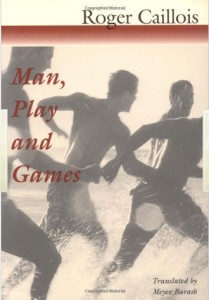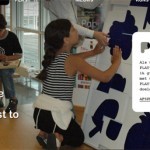A first for me: my work being reviewed online. Lotte Harmsen, who came to play at…
Caillois: Man, Play and Games
 Roger Caillois was a French avant-garde intellectual. In an appendix to ‘Man and the Sacred’ [i] Caillois included a brilliant critique of Johan Huizinga’s theory of play. Between 1946, when this appendix was originally written, and the publication of Les jeux et les hommes[ii] Caillois expanded and systematized his analysis, so that Man, Play and Games is probably the only work today that attempts to create a complete typology of play and games.
Roger Caillois was a French avant-garde intellectual. In an appendix to ‘Man and the Sacred’ [i] Caillois included a brilliant critique of Johan Huizinga’s theory of play. Between 1946, when this appendix was originally written, and the publication of Les jeux et les hommes[ii] Caillois expanded and systematized his analysis, so that Man, Play and Games is probably the only work today that attempts to create a complete typology of play and games.
Where Huizinga traces the influence of play in forming culture, Caillois attempts to categorise ‘play’ in order to be able to compare cultures.
He defines ‘play’ by listing its characteristics. I will quote his list in full here, as I will try out its usefulness as a determinative tool in later chapters:
“But for the present, the preceding analysis permits play to be defined as an activity which is essentially:
1. Free: in which playing is not obligatory; if it were, it would at once lose it’s attractiveness and joyous quality as a diversion;
2. Separate: a separate occupation, carefully isolated from the rest of life;
3. Uncertain: the course of which cannot be determined, nor the result attained beforehand, and some latitude for innovations being left to the players initative;
4. Unproductive: creating neither goods, nor wealth, nor new elements of any kind;
5. Governed by rules: under conventions that suspend ordinary laws; and for the moment establish new legislation, which alone counts;
6. Make-believe: accompanied by a special awareness of a second reality or of a free unreality, as against real life.
Caillois introduces the word ‘game’ without defining it much. Let me, for sake of clarity, differentiate between ‘play’ and ‘game’ here. I take ‘play’ to be a verb, denoting the physical or mental activity of playing, and ‘game’ to be a noun, denoting a certain instance of ‘play’ or a certain set of rules. As in: ‘he played a game of cards with me’.
Caillois divides games into categories by giving four main principles: agôn (competition), alea (chance), mimicry (simulation) and illinx (vertigo). In a lot of games these principles will be paired. For example, patience can be seen as a combination of agôn (the skill of the player) and alea (the random distribution of the cards).
Introducing the mindset of the player into the equation, Caillois differentiates between ludus and paidea modes of playing. In ludus-mode the player subordinates himself to the rules of the game, while the paidea-mode of playing is characterised by creativity, spontaneity and improvisation.
Caillois has a number of interesting things to say about how games are always played in a restricted environment. After discussing how ‘play’ is acted out within precise limits of time and space (the board for chess, the stadium, the racetrack, etc), he states: “In every case, the game’s domain is therefore a restricted, closed, protected universe: a pure space.”[iii] I will add this criterion to the list above, and go into the way play needs and produces space in the following chapter.
Caillois, like Huizinga, sees art as (the production of an) object, thus foreclosing on any link between art and play. “A characteristic of play, in fact, is that it creates no wealth or goods, thus differing from work or art. At the end of the game, all can and must start over again at the same point. Nothing has been harvested or manufactured, no masterpiece has been created, no capital has accrued. Play is an occasion of pure waste: waste of time, energy, ingenuity, skill ….[iv]
[i] Free Press, 1959
[ii] Gallimard, 1958
[iii] Roger Caillois, of Man, Play and Games, English translation, 1961, page 5
[iv] Roger Caillois, of Man, Play and Games, English translation, 1961, page 5
| « Huizinga: Homo Ludens | <-- previous post | next post --> | Sutton-Smith: The Ambiguity of Play » |
|---|







